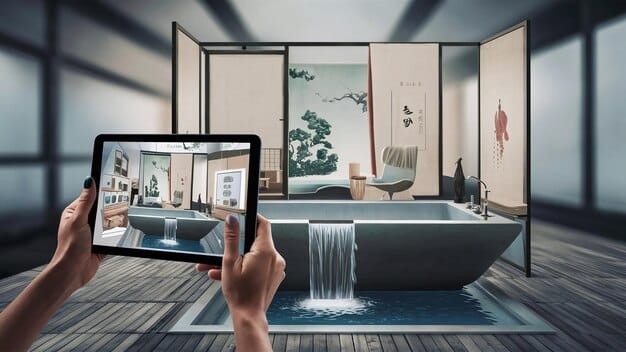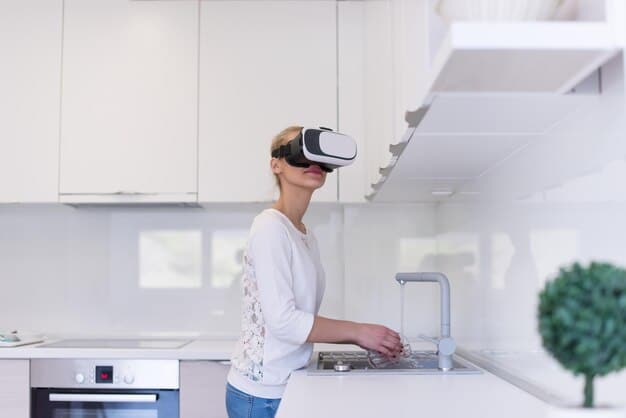AR Home Improvement: Save 10% on Renovations with Augmented Reality

AR-powered home improvement allows US homeowners to visualize and implement renovation projects with augmented reality, potentially saving up to 10% on renovation costs through better planning, reduced errors, and informed purchasing decisions.
Imagine renovating your home without the usual stress of unexpected costs and design mismatches. With AR-powered home improvement, US homeowners are discovering a smarter way to save on renovation projects, potentially cutting costs by up to 10%.
Understanding AR-Powered Home Improvement
Augmented Reality (AR) is revolutionizing various industries, and home improvement is no exception. This technology allows homeowners to visualize changes and improvements to their homes before making any physical alterations, leading to significant cost savings.
What is Augmented Reality?
Augmented reality overlays digital information onto the real world through devices like smartphones, tablets, and AR glasses. In the context of home improvement, it means you can see how new furniture, paint colors, or even entire room layouts would look in your existing space before making any purchases or changes.
How Does AR Save Homeowners Money?
By providing a realistic preview of renovation outcomes, AR helps homeowners avoid costly mistakes, such as purchasing the wrong size furniture or choosing a paint color that doesn’t match their décor. This proactive approach can lead to substantial savings on renovation projects.
- Reduced Errors: AR helps in accurate measurements and visualizations, minimizing errors in design and material selection.
- Informed Decisions: Homeowners can make more informed purchasing decisions by seeing exactly how products will look in their homes.
- Better Planning: AR enables better planning of space and layout, ensuring optimal use of resources.
The integration of AR into home improvement isn’t just a futuristic concept; it’s a practical solution helping homeowners save time, money, and stress.

Applications of AR in Home Renovation
The versatility of AR in home renovation spans across various applications, making it an indispensable tool for US homeowners looking to enhance their living spaces efficiently and cost-effectively.
Virtual Furniture Placement
One of the most popular uses of AR is the ability to virtually place furniture in a room. This feature allows homeowners to see how different pieces will fit and look in their space without the hassle of physically moving them. This is especially useful for large or bulky items like sofas, beds, and cabinets.
Paint and Color Visualization
Choosing the right paint color can be challenging. AR apps allow you to point your device at a wall and instantly see how different colors will look, accounting for lighting and existing décor. This can prevent costly repainting and ensure you’re happy with your color choices.
DIY Projects and Planning
AR can also assist with DIY projects by providing virtual guides and measurements. For example, if you’re installing new flooring, an AR app can help you calculate the amount of material needed and visualize the finished result. This reduces waste and ensures accuracy.
- Kitchen Remodeling: Visualize new cabinets, countertops, and appliances in your kitchen before making any commitments.
- Bathroom Renovations: See how new tiles, fixtures, and layouts will transform your bathroom.
- Outdoor Landscaping: Plan your garden layout, visualize plant placements, and see how outdoor furniture will fit on your patio.
With AR, home renovation becomes a more interactive and informed process, empowering homeowners to make confident decisions.
Case Studies: Real Savings with AR
To truly appreciate the impact of AR in home improvement, let’s look at some case studies where US homeowners have experienced real cost savings and improved project outcomes.
Case Study 1: Living Room Makeover
A homeowner in California wanted to revamp their living room but was unsure about furniture placement and color schemes. Using an AR app, they virtually arranged different furniture layouts and experimented with various paint colors. The result was a perfectly coordinated living room that matched their vision, saving them from potential missteps and approximately $500 in furniture returns and repainting costs.
Case Study 2: Kitchen Remodel
A family in New York planned a kitchen remodel and used AR to visualize different cabinet styles and appliance placements. They realized that a particular cabinet style didn’t fit their kitchen’s aesthetic and avoided purchasing it. They also optimized the layout to maximize space and functionality, saving about $1,000 in potential rework and mismatched appliances.
Case Study 3: Bathroom Upgrade
A homeowner in Texas used AR to plan a bathroom upgrade, visualizing different tile patterns and fixture placements. They discovered that a particular tile pattern made the room appear smaller and chose a different design. This prevented an unsatisfactory outcome and saved them approximately $300 in tile replacement costs.

Choosing the Right AR App for Your Needs
With numerous AR apps available, selecting the right one for your home improvement project can be overwhelming. Here are some factors to consider to ensure you choose an app that aligns with your specific needs and goals.
Features and Functionality
Consider the specific features you need. Some apps specialize in furniture placement, while others focus on paint color visualization or DIY project planning. Choose an app that offers the features most relevant to your project.
User Interface and Ease of Use
A user-friendly interface is crucial for a seamless experience. Look for apps with intuitive navigation and clear instructions. Read reviews to see what other users say about the app’s ease of use.
Compatibility and Device Requirements
Ensure the app is compatible with your device (smartphone or tablet) and operating system (iOS or Android). Some apps may require specific hardware features, such as a LiDAR scanner for accurate depth sensing.
- Reviews and Ratings: Read user reviews and ratings to get insights into the app’s performance and reliability.
- Free vs. Paid: Consider whether a free app meets your needs or if a paid version with more features is worth the investment.
- Customer Support: Check if the app developer offers customer support in case you encounter any issues.
By carefully evaluating these factors, you can select an AR app that enhances your home improvement journey and helps you achieve your desired outcomes.
The Future of Home Improvement with AR
As AR technology continues to advance, its role in home improvement is set to expand even further. Let’s explore some potential future developments and trends that could revolutionize how US homeowners approach renovation projects.
Enhanced Visualization Capabilities
Future AR apps may offer even more realistic and immersive visualizations, incorporating advanced lighting and shading effects. This will allow homeowners to see exactly how new additions will look under different conditions and at various times of day.
Integration with Smart Home Technology
AR could integrate with smart home devices to automate certain tasks. For example, an AR app could control smart lighting to show how different colors will affect the room’s ambiance. It could also adjust smart thermostats to simulate how energy-efficient upgrades will impact heating and cooling costs.
Collaborative Design Tools
AR could facilitate collaborative design, allowing homeowners to work with designers and contractors remotely. Multiple users could view and interact with the same virtual space, making it easier to coordinate and communicate design ideas.
- AI-Powered Design Suggestions: AR apps could use artificial intelligence to analyze your existing décor and suggest complementary design elements.
- 3D Printing Integration: AR could integrate with 3D printers to create custom furniture and décor items tailored to your specific needs.
- Remote Consultation: Homeowners could use AR to get expert advice from designers and contractors without the need for in-person meetings.
The future of home improvement with AR is filled with exciting possibilities that promise to make the renovation process more efficient, cost-effective, and enjoyable.
Overcoming Challenges and Limitations
While AR offers numerous benefits for home improvement, it’s important to acknowledge the challenges and limitations that users may encounter. Understanding these issues can help homeowners navigate them effectively and make the most of AR technology.
Accuracy and Calibration
The accuracy of AR visualizations depends on the device’s sensors and calibration. Inaccurate measurements or faulty depth sensing can lead to discrepancies between the virtual and real-world environments. Regular calibration and using devices with advanced sensors can help mitigate this issue.
Technical Issues and Glitches
Like any technology, AR apps can experience technical issues and glitches. Software bugs, compatibility problems, and performance issues can disrupt the user experience. Keeping your apps updated and using devices that meet the app’s requirements can minimize these problems.
Learning Curve
Some users may find AR apps challenging to use initially. Understanding the app’s features and navigation may require a learning curve. Taking the time to explore the app’s tutorials and practicing with different features can help users become more comfortable with AR technology.
- Lighting Conditions: AR visualizations may be affected by poor lighting conditions. Ensure adequate lighting for accurate renderings.
- Device Performance: Older devices may struggle to run AR apps smoothly. Consider upgrading to a newer device for optimal performance.
- App Updates: Stay updated with app updates to fix bugs and improve functionality.
By addressing these challenges and limitations, homeowners can maximize the benefits of AR and achieve successful home improvement outcomes.
| Key Point | Brief Description |
|---|---|
| 💡 Cost Savings | AR helps avoid costly mistakes, potentially saving up to 10% on renovations. |
| 🛋️ Furniture Placement | Visualize how furniture fits in your space before buying, reducing returns. |
| 🎨 Color Visualization | See how paint colors look on your walls in real-time, avoiding repainting costs. |
| 🛠️ DIY Planning | Assist with measurements and visualizations for DIY projects, reducing waste. |
FAQ
▼
AR has the potential to save homeowners up to 10% on renovation costs by reducing errors and enabling better planning and informed purchasing decisions. This includes savings on furniture returns, repainting, and rework.
▼
Most AR apps are compatible with smartphones and tablets. Some apps may require devices with advanced sensors, such as LiDAR, for accurate depth sensing. Check the app’s requirements before downloading.
▼
Many AR apps are designed with user-friendly interfaces and intuitive navigation. However, there may be a learning curve initially. Tutorials and practice can help users become more comfortable with AR technology.
▼
Yes, AR can provide virtual guides and measurements for DIY projects, helping you calculate materials and visualize the finished result. It can reduce waste and ensure accuracy during the project.
▼
AR apps allow you to see how different paint colors will look on your walls in real-time, accounting for lighting and existing décor. This can prevent costly repainting and ensure you’re happy with your color choices.
Conclusion
AR-powered home improvement is not just a passing trend but a transformative tool that empowers US homeowners to renovate smarter, save money, and achieve their dream living spaces with confidence. By understanding the applications, benefits, and potential challenges of AR, you can harness its capabilities to create a home that reflects your style and meets your needs.





